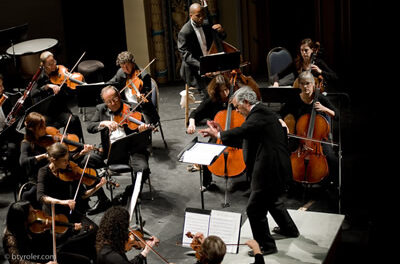A quartet of faculty members from Wake Forest University (did you know that in Italian professore also refers to professional musicians?) offered a delightful smorgasbord of mostly twentieth-century chamber music in the large Brendle Recital Hall of the Scales Fine Arts Center, a space with, as they say in the cinema business, stadium seating, and fine acoustics, so that in spite of a good turnout, there was virtually no one sitting in the first ten rows (a detail that the WFU Music Dept. should work out: within a half-hour of concert both the main door and the handicapped access to the hall were still locked, this on a briskly cold day). Performing were Jaqui Carrasco, violin, Kathryn Levy, flute, Evan Richey, cello and Peter Kairoff, piano.
The concert opened with the Duetto for flute and violin by Emanuel Bach, heard on modern instruments, something rather unusual for eighteenth-century repertoire these days. The work, oddly enough, begins with an Andante in E minor, followed by two quick movements (Allegro and Allegretto) in G. The descending scales of the Andante were properly expressive, and the whole was elegant, beautifully in tune, with excellent ensemble throughout between the two soloists.
Next up came the Sonatina for flute and piano by Eldin Burton (1913-1979). Who? This Sonatina is one of those works that is firmly situated in the repertoire, but from a composer who is virtually unknown. Burton was from Georgia, and studied piano and composition at Juilliard. The sonatina was apparently originally for piano solo, and arranged into its present form. The piece is very much (and very competently) in the French style, with some Spanish touches in the closing movement (marked “quasi fandango”), and it was beautifully rendered by Levy and Kairoff, with a very finely spun flute line, with virtually no vibrato, and excellent control of the third octave (all those notes above the third D).
Some actual French music followed, in the form of the Debussy Sonata for cello and piano, given a muscular performance by Richey, who has a large presence. The whole ensemble came together for the recent (2003) Firebrand by American composer Libby Larsen (b. 1950), which was the only piece to receive some spoken program notes. The work began with fluttering from the piano, flutter-tonguing from the flute, tremolo from the strings, all evoking the flickering of flames, but for better or worse, there was no clear development of the material (to use the fire metaphor, the music might have flared up and then died away), but instead, the music just continued until it stopped abruptly – to my mind, a compositional flaw, and an ending which certainly left the listeners at a loss.
Closing the afternoon was the Madrigal Sonata by Bohuslav Martinu for flute, violin and piano (why a Madrigal?), in which the opening Poco Allegro keeps all the parts, and particularly the treble voices, in continual motion without the sort of the counterpoint one might expect from a trio-sonata texture. The thematic material for the following Moderato/Allegro was more clearly laid out, and one noted that the piece is particularly well-written for the flute (that is, it gave the instrument the things to do that it does beautifully and effectively, rather than writing for it as if it were a violin, for instance). Some hocketing (ping-ponging the tune between the instruments) ratcheted up the energy for the final cadence, which was abundantly well-prepared, sending the listeners off on a high note after an hour of absorbing and energizing music.












